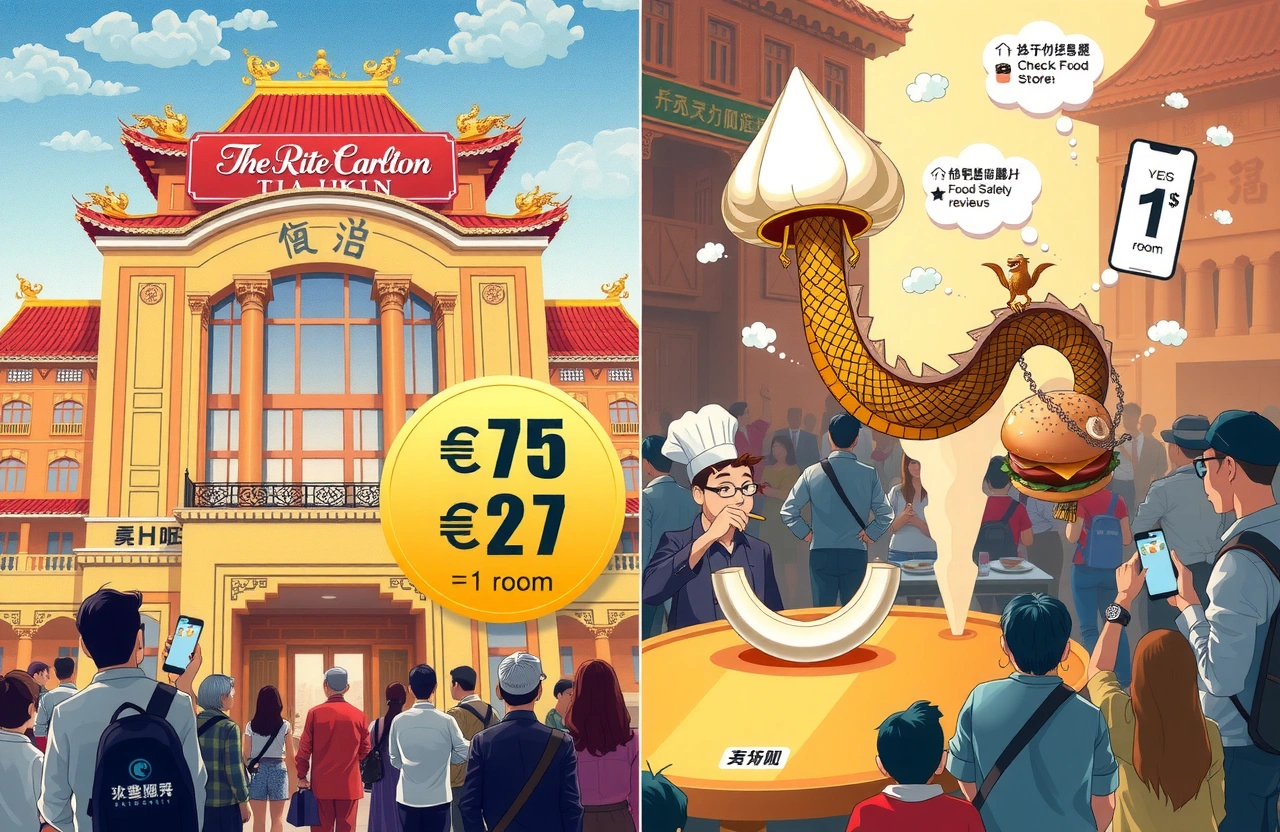Key Insights
\n- Luxury hotels across China are launching street stalls selling ¥10-¥30 meals\n- Prices represent 90% discounts compared to formal hotel dining prices\n- Daily revenue ranges from ¥1,000 to ¥30,000 with mixed profitability\n- Factors include wedding declines, corporate austerity policies, and changing consumption habits\n
The Radical Shift Toward Affordable Dining
\nImagine encountering The Ritz-Carlton’s logo at a sidewalk burger cart instead of an opulent lobby. Across China, luxury hotels have embraced street vending to survive economic turbulence. The extraordinary gap between their formal pricing and street stall offerings reveals a dramatic adaptation strategy in action.\n\nThe benchmark-setting example comes from The Ritz-Carlton Tianjin – where suites costing ¥2,000/night now sell ¥75 wagyu burger combos. Put differently: A guest could buy 27 burger meals for the price of one night’s accommodation. This pattern repeats nationwide.\n\nIn Changzhou, Jiangsu province, the WENPU Hotel rents rooms for ¥1,500/night with ¥300/person dining averages. Their street offerings include ¥18 durian pastries and ¥8 duck wings. The premium Zhongwu Hotel – ranking #1 on Dianping in its district – sells ¥1,000 rooms and ¥525/person meals, yet offers street stalls selling signature dishes like ¥48 brine duck.\n\nThese luxury hotel street stalls often undercut nearby restaurants. Huiyanlou in Anhui provides ¥120/person restaurant meals but street-sells ¥48 crayfish and ¥1 steamed buns.\n\nThe transition signifies more than menu adjustments. Previously, hotels offered “poverty alleviation packages” and “leftover blind boxes” (surprise bags of unsold buffet items). Today’s luxury hotel street stalls represent purpose-built operations targeting commuters and neighborhood residents.\n\n
The Redefined Product Portfolio
\n
From Banquets to Box Lunches
\nThe transformation extends beyond pricing. Where hotels once specialized in banquet dishes requiring elaborate preparation and presentation, today’s street stall menus focus on convenience items:\n- Portable halal specialties like Liangpi noodles with crayfish\n- ¥10-25 boxed lunches pairing proteins with vegetables\n- Budget-friendly dim sum including ¥1 steamed buns\n\nThis strategic diversification captures distinct consumption occasions missing from hotel revenue streams.\n\n
Consumer Psychology Shift
\nLocal consumers reveal fascinating behavioral patterns. As Shanghai office worker Liao Ming (廖明) explained: “I’d never walk past those intimidating hotel doors before. But seeing Zhongwu Hotel staff selling ¥48 plates outside? That broke the psychological barrier.” Trust perception ranks highest in consumer surveys, with 78% citing hygiene confidence as their primary motivation.\n\nDemand appears robust – Zhongwu Hotel stalls reported sell-outs within 30 minutes daily during their pilot phase. Social media analytics show location searches for luxury hotel street stalls increased 300% quarterly.\n\nDespite enthusiasm, criticisms persist. Nanjing resident Chen Wei (陈伟) noted: “My ¥15 portion was smaller than other vendors’ ¥12 equivalent – this smells like brand exploitation.” Balanced value perception remains vital for sustainable traction.\n\n
The Profitability Tightrope
\n
Revenue Realities
\nFinancial transparency remains limited, but available data reveals stark contrasts. Management from Changzhou’s WENPU Hotel privately acknowledged ¥1,500 daily revenue – barely covering two staff wages. Conversely, The Ritz-Carlton’s mobile kitchenette reportedly generates ¥15,000-¥30,000 daily.\n\nCrucially, most outlets operate through existing kitchen systems. This marginal cost approach enables profitability despite low prices. A Wuhan Shangri-La executive shared anonymously: “Using idle morning kitchen capacity lets us produce ¥8,000 in incremental revenue at 65% margins.”\n\n
The Cost Conundrum
\nPersistent challenges include:\n- Luxury hotels’ operating cost structures remain 35% higher than street operators\n- Staffing represents 25-30% of revenue versus 15% for independent stalls\n- Premium locations impose rental expenses street vendors avoid\n\nWhen food costs alone consume 45-60% of retail prices, profitable scaling requires careful management. Industry consultant Wang Lin (王琳) noted: “Hotel street stalls succeed only through clever use of existing infrastructure and slack resources.”\n\n
Underlying Market Pressures
\n
The Wedding Crisis Impact
\nIndustry-wide fundamentals reveal deeper issues than recent “no alcohol” policies imply. While Beijing’s government reception restrictions reportedly reduced hotel banquet revenue by 20%, marriage data paints a grimmer picture.\n\nCivil Affairs Ministry figures show marriage registrations plummeting 20.5% YoY to 6.1 million couples nationally. Wedding banquets historically provided 25-40% of premium hotels’ F&B revenue.\n\n
Performance Metrics Plateau
\nMetrics reinforce the struggle:\n- RevPAR (revenue per available room) fell 9.7% nationwide in 2024\n- Occupancy rates dipped to 58.8% (down 2.5% YoY)\n- Restaurant spending reductions affected 31.8% households\n\nThese combine with contrasting counter-trends: Fast-casual dining grew 7.5% as consumers prioritized budget-friendly convenience.\n\n
Corporate Performance Declines
\nPublicly traded operators face deterioration: Jin Jiang Hotels’ Q1 2025 net profits crashed 81% despite ¥2.94 billion revenue. Smaller operators like Nanjing’s Jinling Hotel similarly reported 18% profit erosion.\n\nAnalysts attribute this partly to lagging corporate group bookings from 2024’s anti-corruption policy extensions.\n\n
Strategic Implications and Pathways
\n
Brand Integrity Concerns
\nBeyond finance, executives confront existential positioning questions. As marketing professor Zhang Min (张敏) cautioned: “When Tiffany sells discount pendants at Walmart, they risk diminishing aspirational value. Hotels face identical leveraging dangers.”\n\nTypically positioning-dependent segmentation becomes blurred when executives serve Michelin-starred chefs’ creations through folding tables.\n\n
Innovation Frameworks
\nLeading chains explore alternatives beyond temporary stalls:\n- Micro-brand development (distinct identities for affordable outlets)\n- Adaptive venue designs (modular event spaces replacing grand ballrooms)\n- Membership tiering prioritization (value-based retention programs)\n\nShangri-La’s KFC-style “Eastern Express” exemplifies successful micro-branding – generating ¥400 million annually without compromising core properties.\n\n
Sustaining Transformation Momentum
\nThe street stall phenomenon crystallizes hospitality’s broader adaptation imperative. Successful operators blend short-term relief strategies with fundamental reinvention.\n\nThree imperatives emerge:\n- Cost engineering: Rationalizing buying groups or automation kitchens\n- Experience bridging: Creating transitional products between street and formal dining\n- Talent restructuring: Training cross-functional flex teams\n\nUltimately, graduation paths matter most. Commuter buying ¥25 noodles today may convert to tomorrow’s ¥350 banquet patrons, but only through thoughtful experience design.\n\nHoteliers must capitalize on current brand halo effects while innovating revenue pipelines. Guangdong Tourism Association Deputy Director Chen Xia (陈霞) summarized: “This humility serves crisis well, but resurgence requires architectural solutions.” For travelers and locals alike, observe pioneering adaptations – buy lunch if you spot hotel setups, photograph menus, discuss experiences online, and track these brands’ evolution.\n\nThe hospitality leaders thriving beyond 2025 won’t merely sell cheaper food: They’ll reconstruct value propositions around accessibility without sacrificing premium prestige.




